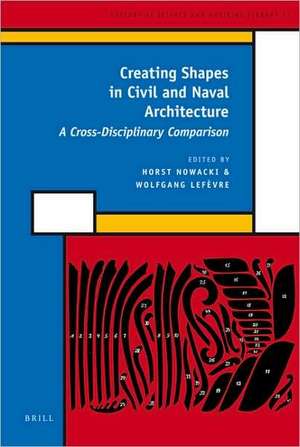Creating Shapes in Civil and Naval Architecture: A Cross-Disciplinary Comparison: History of Science and Medicine Library, cartea 11
Horst Nowacki, Wolfgang Lefèvreen Limba Engleză Hardback – 29 iun 2009
This volume is a collection of contributions by outstanding scholars in their fields of study, archaeology, history of architecture and ship design, in classic antiquity, the Middle Ages and the early modern period. The volume presents a comparative knowledge history in these two distinct branches of construction engineering.
Preț: 721.88 lei
Preț vechi: 880.33 lei
-18% Nou
Puncte Express: 1083
Preț estimativ în valută:
138.15€ • 143.70$ • 114.05£
138.15€ • 143.70$ • 114.05£
Carte indisponibilă temporar
Doresc să fiu notificat când acest titlu va fi disponibil:
Se trimite...
Preluare comenzi: 021 569.72.76
Specificații
ISBN-13: 9789004173453
ISBN-10: 9004173455
Pagini: 398
Dimensiuni: 160 x 240 x 28 mm
Greutate: 0.91 kg
Editura: Brill
Colecția Brill
Seria History of Science and Medicine Library
ISBN-10: 9004173455
Pagini: 398
Dimensiuni: 160 x 240 x 28 mm
Greutate: 0.91 kg
Editura: Brill
Colecția Brill
Seria History of Science and Medicine Library
Cuprins
List of Figures
Preface
Color plate section
INTRODUCTION
1. Shape Creation Knowledge in Civil and Naval Architecture, Horst Nowacki
ANTIQUITY
2. On the Use of Design in Ancient Mediterranean Ship Construction, Patrice Pomey
3. Were the Hittites Able to Build a Replica of an Egyptian Ship According to Their Own Drawings?, Lucien Basch
Reply to Lucien Basch by Patrice Pomey
4. Markings and Pegs: Clues to Geometrical Procedures of Roman Naval Architecture?, Ronald Bockius
5. Ancient Greek and Roman Architects’ Approach to Curvature – The Corinthian Capital, Entasis and Amphitheaters, Mark Wilson Jones
MIDDLE AGES
6. “To Design” and “to Build” Mediaeval Ships (Fifth to Fifteenth Centuries) – The Application of Knowledge Held in Common with Civil Architecture, or in Isolation?, Eric Rieth
7. Boat and Boat House. The Conceptional Origins of Clinker Boats and Boat-Shaped Halls of the Fourth –Eleventh Centuries in Scandinavia, Ole Crumlin-Pedersen
8. Gothic and Renaissance Design Strategies in Stonecutting, Enrique Rabasa Díaz and José Calvo López
9. On Late-Gothic Vault Geometry, Jos Tomlow
MODERN ERA
10. The Shipbuilding Text of Michael of Rhodes, David McGee
11. Naval Architecture Digitalized – Introducing Arithmetic and Geometry into Late Mediaeval Shipwrightry, Ulrich Alertz
12. Pregnant Columns. From Word to Shape, Antonio Becchi
13. From One Curve to Another or the Problem of Changing Coordinates in Stereotomic Layouts, Joël Sakarovitch
14. The Squinch of Anet, Martina Lenz
Conclusion
APPENDICES
A. From Words to Technical Practices: Moulds and Naval Architecture in the Middle Ages, Eric Rieth
B. The Rare Traces of Constructional Procedures in “Practical Geometries”, Jens Høyrup
C. Draughting Curves Used in Ship Design, Jobst Lessenich
D. Bibliographical Notes on Historical Metrology, Compiled by Jobst Lessenich
Index
Preface
Color plate section
INTRODUCTION
1. Shape Creation Knowledge in Civil and Naval Architecture, Horst Nowacki
ANTIQUITY
2. On the Use of Design in Ancient Mediterranean Ship Construction, Patrice Pomey
3. Were the Hittites Able to Build a Replica of an Egyptian Ship According to Their Own Drawings?, Lucien Basch
Reply to Lucien Basch by Patrice Pomey
4. Markings and Pegs: Clues to Geometrical Procedures of Roman Naval Architecture?, Ronald Bockius
5. Ancient Greek and Roman Architects’ Approach to Curvature – The Corinthian Capital, Entasis and Amphitheaters, Mark Wilson Jones
MIDDLE AGES
6. “To Design” and “to Build” Mediaeval Ships (Fifth to Fifteenth Centuries) – The Application of Knowledge Held in Common with Civil Architecture, or in Isolation?, Eric Rieth
7. Boat and Boat House. The Conceptional Origins of Clinker Boats and Boat-Shaped Halls of the Fourth –Eleventh Centuries in Scandinavia, Ole Crumlin-Pedersen
8. Gothic and Renaissance Design Strategies in Stonecutting, Enrique Rabasa Díaz and José Calvo López
9. On Late-Gothic Vault Geometry, Jos Tomlow
MODERN ERA
10. The Shipbuilding Text of Michael of Rhodes, David McGee
11. Naval Architecture Digitalized – Introducing Arithmetic and Geometry into Late Mediaeval Shipwrightry, Ulrich Alertz
12. Pregnant Columns. From Word to Shape, Antonio Becchi
13. From One Curve to Another or the Problem of Changing Coordinates in Stereotomic Layouts, Joël Sakarovitch
14. The Squinch of Anet, Martina Lenz
Conclusion
APPENDICES
A. From Words to Technical Practices: Moulds and Naval Architecture in the Middle Ages, Eric Rieth
B. The Rare Traces of Constructional Procedures in “Practical Geometries”, Jens Høyrup
C. Draughting Curves Used in Ship Design, Jobst Lessenich
D. Bibliographical Notes on Historical Metrology, Compiled by Jobst Lessenich
Index
Notă biografică
Horst Nowacki, Dr.-Ing. (1963) in Naval Architecture, Technical University of Berlin, Prof. of Ship Design at TU Berlin (1974-1998), has published about 200 articles and books on naval architecture and ship theory including Computational Geometry for Ships, co-authored with M.I.G. Bloor and B. Oleksiewicz (World Scientific Publ., Singapore, 1995).
Wolfgang Lefèvre, Ph.D. (1972) in Philosophy, Freie Universität Berlin, Professor for Philosophy at the Freie Universität Berlin and Senior Scholar at the Max Planck Institute for the History of Science, Berlin, until 2006. He has published extensively on history of philosophy, science, and technology including Picturing Machines (MIT Press, 2004).
Wolfgang Lefèvre, Ph.D. (1972) in Philosophy, Freie Universität Berlin, Professor for Philosophy at the Freie Universität Berlin and Senior Scholar at the Max Planck Institute for the History of Science, Berlin, until 2006. He has published extensively on history of philosophy, science, and technology including Picturing Machines (MIT Press, 2004).












